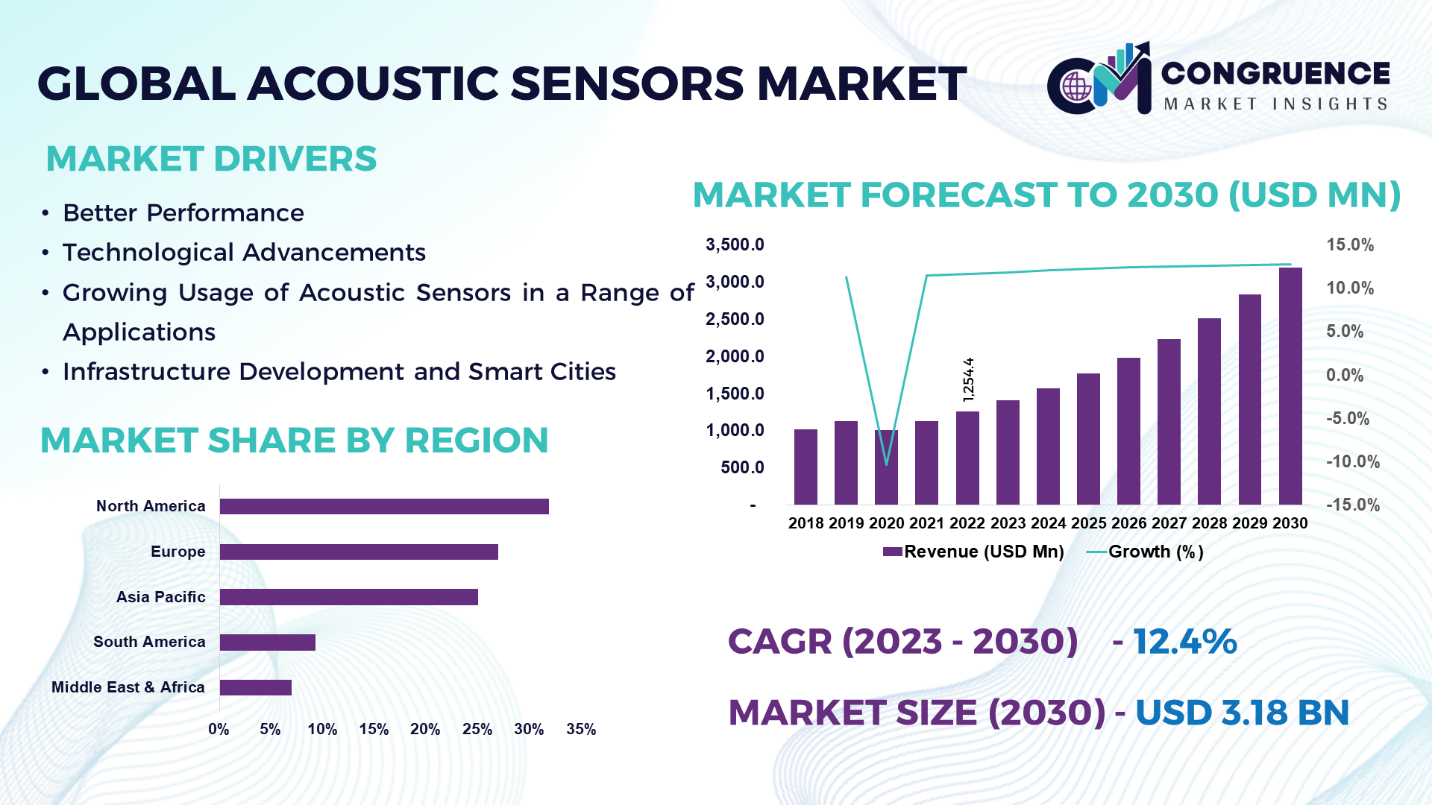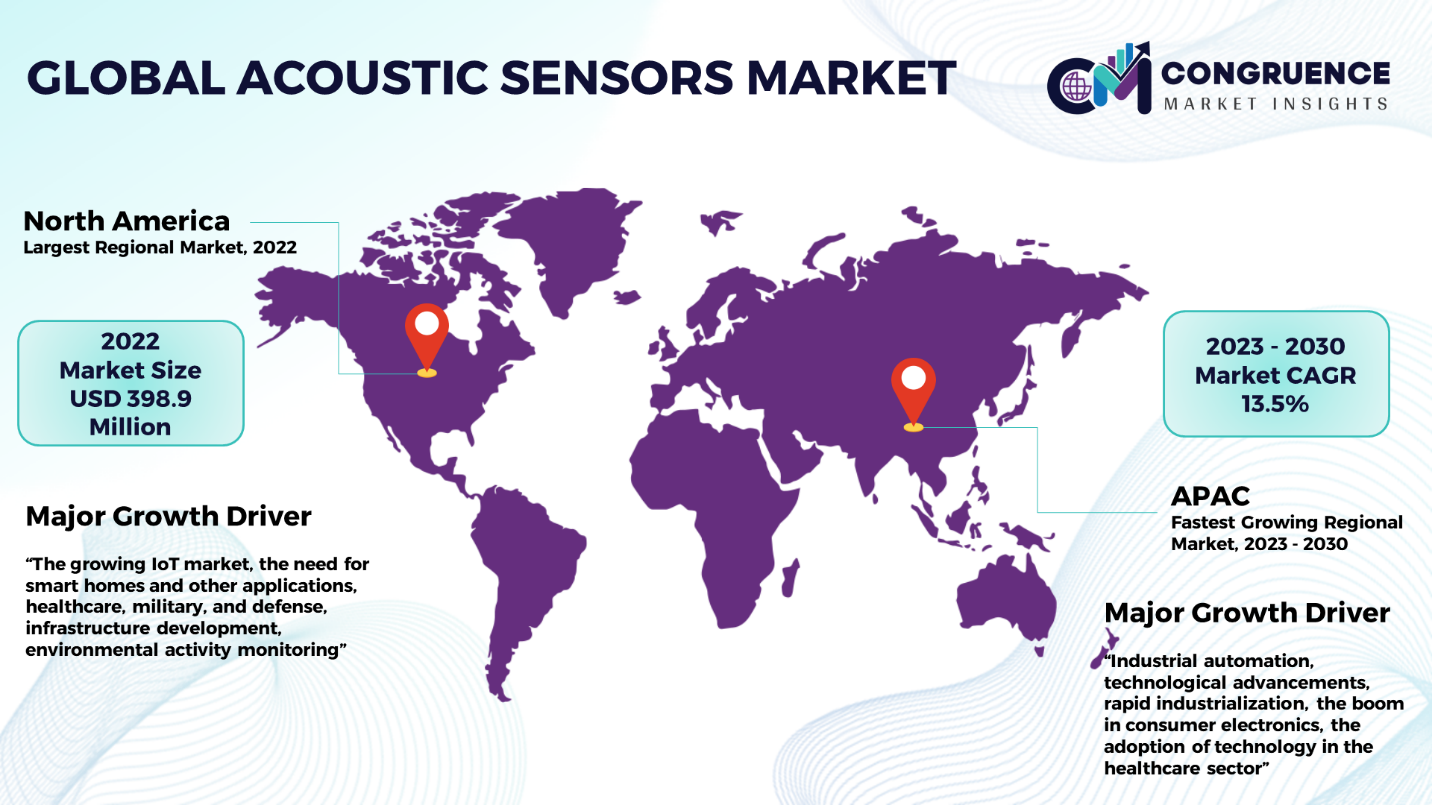Reports
The Global Acoustic Sensors Market was valued at USD 1,254.4 Million in 2022 and is anticipated to reach a value of USD 3,183.4 Million by 2030 expanding at a CAGR of 12.4% between 2023 and 2030.
Acoustic sensors are designed to detect sound waves and convert them into electrical impulses. They are widely used in many different industries, such as consumer electronics, healthcare, automotive, and industrial applications. The growing requirement for smart devices, IoT integration, and effective monitoring and detection systems are driving the sizeable target market for Acoustic Sensors. Acoustic sensors include piezoelectric, capacitive, and optical sensors, among others. Piezoelectric sensors are perfect for accurate measurements in industrial and automotive applications because they transform mechanical stress into electrical impulses. Capacitive sensors, which are appropriate for touch and proximity applications in consumer electronics, sense changes in capacitance. Optical sensors are highly sensitive and accurate for monitoring environments and medical conditions since they use light to detect sound waves. These many sensor types meet specific business needs and increase demand for acoustic sensors by offering adaptable solutions for a variety of industries, from consumer electronics and industrial machinery to automotive safety systems and healthcare devices.

Acoustic Sensors Market Major Driving Forces
Better Performance: In a competitive setting, acoustic wave sensors perform better than conventional sensors due to features consisting of wireless operation, quick response times, and passive operation. As a result, the need for the use of acoustic sensors is growing, particularly in high-tech applications.
Technological Advancements: Technological developments in the acoustic sensors sector have resulted in the development of more sustainable and effective production techniques, which has further boosted market expansion.
Growing Usage of Acoustic Sensors in a Range of Applications: Due to its many benefits, including the ability to monitor and maintain patient health records, acoustic sensors are widely used in a variety of industries, including IT and telecommunication, automotive, consumer electronics, aerospace and defense, healthcare, and others. These factors are expected to fuel the growth of the acoustic sensor market.
Infrastructure Development and Smart Cities: Expanding the use of acoustic sensors in smart cities for uses such as environmental monitoring, public safety, and traffic control. Projects related to infrastructure that use sound sensors to keep an eye on the condition of buildings and bridges.
Acoustic Sensors Market Key Opportunities
Proliferation of Electronic Technology: The market for acoustic sensors is experiencing significant growth due to the widespread use of a variety of electronic technologies. Since more people in both advanced and emerging nations are using smartphones, tablets, and other electronic devices, there is a huge need for acoustic sensing technology on the market.
Robotics Industry: The need for acoustic sensors is increasing due to the rise in the automation and robotics sectors. Acoustic sensors are the ideal solution to robotics manufacturers' desire for more precise data input. Hence, offering a significant chance for the future.
Defense Industry: Every nation's military needs the most advanced sensors to gather more accurate and precise information about the whereabouts of the enemy. In the defense sector, advanced acoustic sensor technology can be used for security, surveillance, and reconnaissance purposes.
Acoustic Sensors Market Key Trends
· A trend in the direction of streamlined and smaller acoustic sensors, which make it simpler to integrate them into different kinds of gadgets.
· Continuous advancement of acoustic sensor Micro-Electro-Mechanical Systems (MEMS) technology, which will lead to better results.
· An increasing number of people are interested in combining environmental, gyroscope, and accelerometer sensors with acoustic ones.
· The incorporation of wireless communication capabilities in acoustic sensors facilitates data transmission and remote monitoring.
· Employing more sophisticated signal processing methods and machine learning algorithms to improve the precision and effectiveness of acoustic sensors.
· Increasing use of acoustic sensors in smart city programs to track traffic, public safety, and noise levels.
· Growth of voice and speech recognition applications for acoustic sensors in consumer electronics and smart home appliances.
Region-wise Market Insights
North America accounted for the largest market share at 31.8% in 2022 whereas, Asia Pacific is expected to register the fastest growth, expanding at a CAGR of 13.5% between 2023 and 2030.

The global market for acoustic sensors is led by North America, with a market share of 31.8% and a value of USD 398.9 million. The market in this region is propelled by a number of factors, including the use of acoustic sensors in various automotive applications, consumer demand for electronics, industrial automation, the growing IoT market, the need for smart homes and other applications, healthcare, military, and defense, infrastructure development, environmental activity monitoring, demand in the energy sector, and technological advancements. With a predicted CAGR of 13.5%, the Asia-Pacific region is anticipated to grow at the quickest rate in this market. Industrial automation, technological advancements, rapid industrialization, the boom in consumer electronics, the adoption of technology in the healthcare sector, research and development initiatives, regulatory compliance and standards, partnerships and collaborations, smart manufacturing trends, the growing demand for wearable devices, the regional focus on sustainable technologies, the development of 5G connectivity infrastructure, the influence of global technology giants in the region, and cross-industry collaboration for sensor integration are the factors driving this market.
Market Competition Landscape
The worldwide acoustic sensors market is fiercely competitive, with many manufacturers and merchants. These businesses use a variety of tactics to compete in the market, including product innovation, joint ventures, and mergers and acquisitions. Their market development is demonstrated by the sizeable contracts they secure for the application of their acoustic sensor technology. These advancements demonstrate the evolution of the business and the large corporations' dedication to furthering the science of acoustic sensors. To make a name for themselves, a number of new competitors have entered the acoustic sensor market by utilizing innovation and development techniques. They have increased the variety of goods they offer, made investments in cutting-edge sound sensors, and concentrated on enhancing scalability and efficiency. Despite this, the industry's leading players hold a significant portion of the market because of their extensive experience, loyal customer base, efficient distribution systems, and continuous R&D expenditures. By offering a large selection of acoustic sensor solutions together with thorough post-purchase help and maintenance, they establish and uphold their dominance as the industry's trusted leaders. Among the leading companies in the market are:
· Knowles Corporation
· STMicroelectronics N.V.
· Bosch Sensortec
· TDK Corporation (InvenSense)
· Cirrus Logic
· Infineon Technologies AG
· Analog Devices, Inc.
· AAC Technologies Holdings Inc.
· Honeywell International Inc.
· Molex LLC
· Vesper Technologies, Inc.
· Partron Co., Ltd.
· NeoMEMS Technologies, Inc.
· PUI Audio, Inc.
· Vesper MEMS
|
Report Attribute/Metric |
Details |
|
Market Revenue in 2022 |
USD 1,254.4.0 Million |
|
Market Revenue in 2030 |
USD 3,183.4 Million |
|
CAGR (2023 – 2030) |
12.4% |
|
Base Year |
2022 |
|
Forecast Period |
2023 – 2030 |
|
Historical Data |
2018 to 2022 |
|
Forecast Unit |
Value (US$ Mn) |
|
Key Report Deliverable |
Revenue Forecast, Growth Trends, Market Dynamics, Segmental Overview, Regional and Country-wise Analysis, Competition Landscape |
|
Segments Covered |
· By Type (Surface Acoustic Wave, Bulk Acoustic Wave) · By Devices (Resonator, Delay Line) · By Application (Food and Beverages, Military, Automotive, Industrial, Healthcare, Environmental) |
|
Geographies Covered |
North America: U.S., Canada and Mexico Europe: Germany, France, U.K., Italy, Spain, and Rest of Europe Asia Pacific: China, India, Japan, South Korea, Southeast Asia, and Rest of Asia Pacific South America: Brazil, Argentina, and Rest of Latin America Middle East & Africa: GCC Countries, South Africa, and Rest of Middle East & Africa |
|
Key Players Analyzed |
Knowles Corporation, STMicroelectronics N.V., Bosch Sensortec, TDK Corporation (InvenSense), Cirrus Logic, Infineon Technologies AG, Analog Devices, Inc., AAC Technologies Holdings Inc., Honeywell International Inc., Molex LLC, Vesper Technologies, Inc., Partron Co., Ltd., NeoMEMS Technologies, Inc., PUI Audio, Inc., Vesper MEMS |
|
Customization & Pricing |
Available on Request (10% Customization is Free) |
